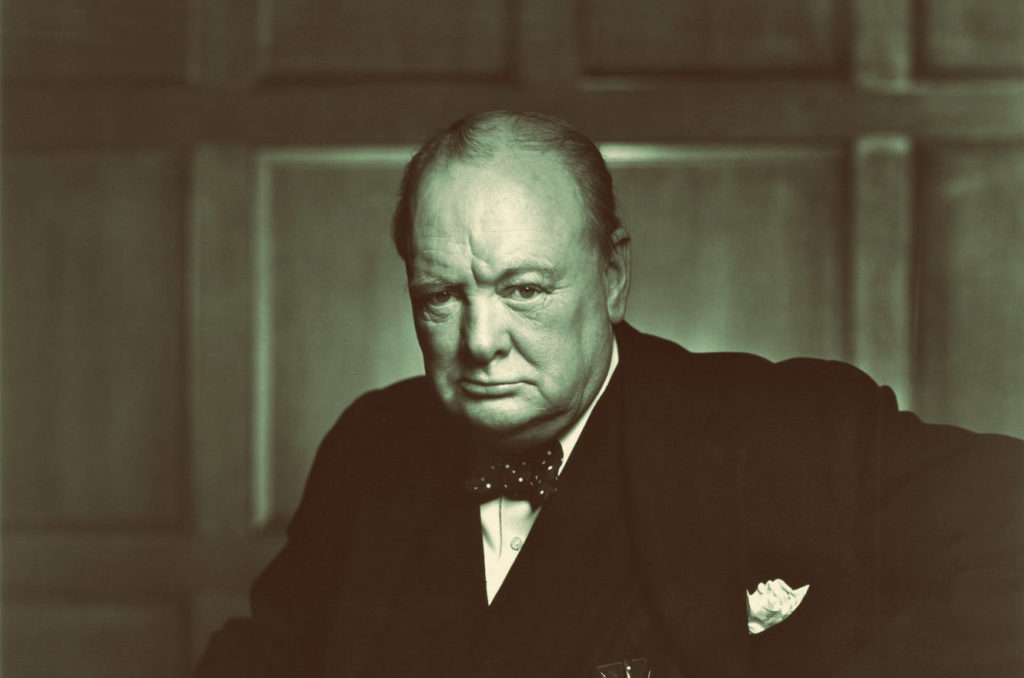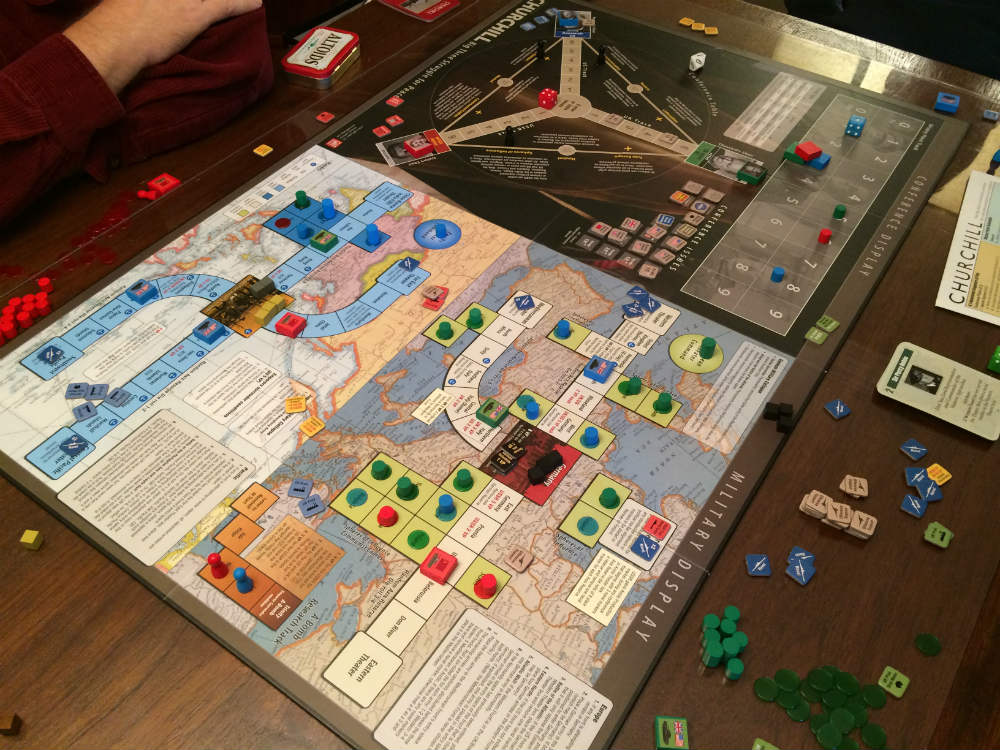We Shall Fight Them on the Tabletop: What the Game of “Churchill” Teaches Us About Alliance Politics

“Diplomacy is the art of telling people to go to hell in such a way that they ask for directions.”
– Winston Churchill
Before there was a Cold War, Winston Churchill was a cold warrior. Churchill saw Communism as such a scourge that he supported sending British troops to Russia in 1918 to quash the Reds.
So why did this Churchill send scarce British military supplies to Russia in 1941? Because, in Churchill’s eyes, there could be no other choice. How could Moscow’s ideology matter when civilization quivered under the thread of Nazi jackboots? Did His Majesty’s prime minister not have the obligation, nay the duty, to place the fate of the world above mere politics? As Churchill told his personal secretary, upon being informed that Germany had invaded the Soviet Union, “If Hitler invaded Hell, I would make at least a favorable reference to the devil in the House of Commons.” And as he told his country that evening
No one has been a more consistent opponent of Communism for the last twenty-five years. I will unsay no word I have spoken about it. But all this fades away before the spectacle which is now unfolding. The past, with its crimes, its follies, its tragedies, flashes away … The Russian danger is therefore our danger, and the danger of the United States, just as the cause of any Russian fighting for hearth and house is the cause of free men and free peoples in every quarter of the globe.
And so Churchill’s Britain allied with the Soviet Union and, later that year, the United States. Consider what the world might look like today had the famous Grand Alliance disintegrated and the Soviet Union concluded a separate peace with Hitler, or had America focused on the Pacific War at the expense of defeating Nazi Germany.
To understand Churchill’s pragmatism is to understand Churchill the game. With two Churchill biopics in theaters this year, what would he make of his name being applied to a board game? No doubt he would thought it a trifling but deserved recompense for saving the world. So let’s examine a game that allows us to step into Churchill’s shoes as he juggles the interests of the British Empire with maintaining the alliance to defeat Hitler. What can it teach us about making and breaking alliances today?
The Rules of the Game
Churchill, from historical wargame publisher GMT, isn’t about the man himself. Rather, it is a simulation of coalition politics. Like classic games such as Diplomacy, it’s about making friends while planning to ultimately betray them. It tackles that most difficult question: How do you maximize your national self-interest without fracturing an alliance? There was a reason Napoleon said that he would rather fight a coalition than be a part of one.
Churchill puts three players into the shoes of Churchill, Roosevelt, and Stalin as they recreate the Grand Alliance of World War II. The goal of the game is to lead your nation to victory while still keeping together the coalition that will — hopefully — defeat the Axis.
It is wargame where the battlefields of World War II are nothing more than a backdrop for diplomatic infighting. The game comprises 10 rounds, corresponding to major political conferences during the second half of the war, such as Casablanca, Tehran, and Yalta.
Visually, the game resembles Candyland mixed with poker. Churchill is fought over a map of Europe, the Mediterranean, and Asia, divided into boxes corresponding to the locations of battlefields in Ukraine, Italy, France, and elsewhere. Those boxes and the battles they represent pave the way to Berlin and Tokyo. Each box, occupied by a certain number of wooden cubes depicting Axis armies and fleets, promises varying numbers of “victory points” to each player. For example, the United States gains more points for capturing Pacific boxes, while the British score higher in the Mediterranean. To capture those boxes and gain the points they offer, players roll dice. The odds of capturing boxes are increased by committing ground and naval support markers.

Garnering those resources for your nation is the heart of the game. In each turn (conference), a certain number of support markers and other tokens are randomly drawn from a cup (representing the items on the conference agenda). Players bid for these tokens by playing from their hand of Staff Cards, which depict the various military and political personalities who attended these conferences, such as Marshall, Eden and Zhukov. Each historical figure has a negotiation value, with the marker being won by the player with the highest total. Players will never have enough Staff Cards to win every agenda item, so they must carefully select items and allocate cards.
The Game Applied to Real-Life Diplomacy
What can a tabletop game teach real-life leaders about diplomacy? Quite a lot, it turns out. The tabletop and the negotiating table share a lot in common.
For example, regarding President Donald Trump’s skepticism toward NATO, Churchill offers a caution about how to treat your allies. In most games, the winner is the one who gets the most points. Naturally, that encourages a strategy of grabbing every point you can. You can do this in Churchill, but here’s the catch: If the first-place player’s score is too far ahead of the scores of the other two contenders, the second-place player wins.
This bears repeating. If you are too successful compared to your coalition partners, you lose. For example, the U.S. player can choose to maximize his or her score by concentrating resources in the Pacific, where America can get the most points. But this would come at the expense of supporting the British and Soviet campaigns in Europe, the Mediterranean, and Burma. And if floundering British and Soviet scores are the result, Roosevelt is considered to have broken the alliance and America loses. As Churchill illustrates, short-term gains may prove expensive in the long run.
This non-zero-sum thinking is counter-intuitive to most games, sports, business, and wars. But it also explains why the Big Three alliance endured when the coalitions against Napoleon so often did not. The Allies had more than their share of quarrels and suspicions, whether over the fate of postwar Poland, the British dragging their feet on landing in France, or the Americans pressuring the Europeans to dismantle their colonial empires. By 1945, the Grand Alliance had disintegrated, but not before it had achieved its purpose.
The game of Churchill also captures the constraints that alliances impose on their members. For example, when players bid for resources during a conference, one of the prizes to be gained are “directed offensive” tokens. These let you decide where the other players allocate their forces. Russia doesn’t want the Americans beating them to Berlin? Then Moscow can use a directed offensive to make the United States focus on the Pacific. Players may also steal support markers from each other, in effect using the conference to successfully demand aid from each other (the United States tends to have the most support markers, but is also most likely to have to fork them over to other players).
Two tokens are of particular interest: the “Second Front” and “Russia Declares War on Japan.” These must be in play during a given conference for the Normandy and Manchurian campaigns to begin. Skillful play during a conference can ensure that the tokens are active — or not. Thus Britain, which scores more points for advancing in the Mediterranean than Northwest Europe, has an incentive to delay the D-Day invasion, while Stalin might prefer to declare war on Japan only after Germany is defeated. Ultimately the game isn’t just about winning agenda items that you want, but also ensuring that your opponents (excuse me, allies) don’t force you into implementing a strategy you don’t want.
“Diplomacy is the art of telling people to go to hell in such a way that they ask for directions.”
The ultimate lesson of Churchill is that diplomacy matters. The game simulates this through cards and dice (players can make agreements among themselves, though the rules emphasize that these are not binding). But the game beautifully illuminates how clever, incompetent or perhaps unlucky diplomacy at a conference table can profoundly influence a nation’s strategy.
Churchill also illustrates an essential truth of both alliances and marriages: conflict and cooperation must exist, even if in uneasy harmony. To defeat the Axis, the Allies must work together. America, Russia, and Britain will win some issues at the conference table, and lose others. There is no shame in not winning it all, as long as you win what you need.
Under the Trump administration, the U.S. State Department is losing seasoned diplomats. In fact, diplomacy and alliance-building seem to have lost ground to belligerent tweets and unilateral actions. But as Churchill the man and Churchill the game would agree, this is no strategy for victory.
Michael Peck is a defense writer who frequently covers defense wargaming, technology and military history. His work has appeared in Foreign Policy, Politico, The National Interest, Slate, Forbes, and other publications. He holds an MA in political science from Rutgers University.
